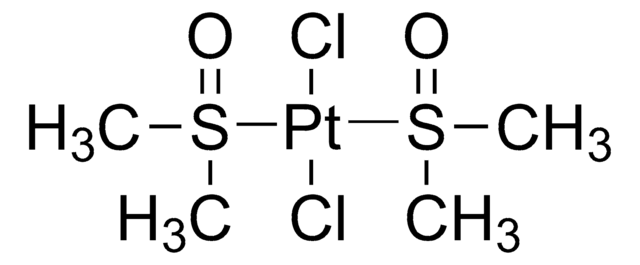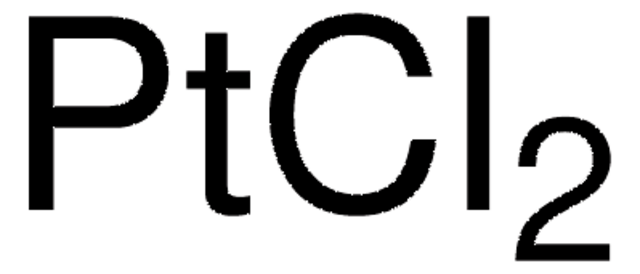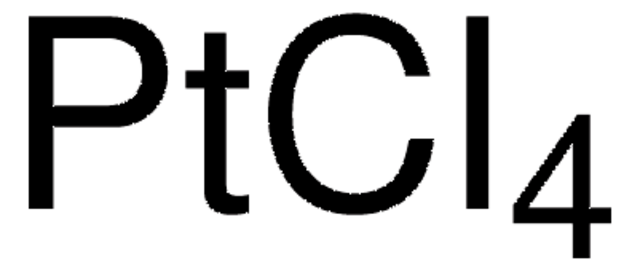520853
Potassium tetrachloroplatinate(II)
≥99.9% trace metals basis
Synonyme(s) :
Potassium platinum(II) chloride
About This Item
Produits recommandés
Niveau de qualité
Essai
≥99.9% trace metals basis
Forme
powder or crystals
Composition
Pt, ≥46.2%
Impuretés
≤1000.0 ppm Trace Metal Analysis
Densité
3.38 g/mL at 25 °C (lit.)
Chaîne SMILES
[K+].[K+].Cl[Pt--](Cl)(Cl)Cl
InChI
1S/4ClH.2K.Pt/h4*1H;;;/q;;;;2*+1;+2/p-4
Clé InChI
RVRDLMCWUILSAH-UHFFFAOYSA-J
Vous recherchez des produits similaires ? Visite Guide de comparaison des produits
Description générale
Application
- As a precursor to prepare platinum nanoparticles and mesoporous platinum nanospheres with tunable pore sizes.
- As a catalyst for selective methane oxidation through C-H activation. In addition, to synthesize octahedral Pd@Pt1.8Ni nanocrystals with an ultrathin PtNi alloy shell. The nanocrystals exhibited better ORR activity and durability than the commercial Pt/C for fuel cells.
- To prepare Pt atomic clusters were synthesized using a one-step carbon-defect-driven electroless deposition method. These catalysts demonstrated low overpotential, high activity for the hydrogen evolution reaction, exceptional stability, and improved utilization efficiency of Pt. The Pt-AC/DG (Atomic Clusters/Defective Graphene) cathode showed excellent hydrogen production activity, remarkable stability, and significantly reduced Pt usage compared to the Pt/C catalyst.
- As a starting material to synthesize cyclometalated platinum(II) complexes with long-lived luminescence in solution.
Caractéristiques et avantages
Mention d'avertissement
Danger
Mentions de danger
Conseils de prudence
Classification des risques
Acute Tox. 3 Oral - Eye Dam. 1 - Resp. Sens. 1 - Skin Irrit. 2 - Skin Sens. 1
Code de la classe de stockage
6.1C - Combustible acute toxic Cat.3 / toxic compounds or compounds which causing chronic effects
Classe de danger pour l'eau (WGK)
WGK 1
Point d'éclair (°F)
Not applicable
Point d'éclair (°C)
Not applicable
Équipement de protection individuelle
Eyeshields, Faceshields, Gloves, type P2 (EN 143) respirator cartridges
Faites votre choix parmi les versions les plus récentes :
Déjà en possession de ce produit ?
Retrouvez la documentation relative aux produits que vous avez récemment achetés dans la Bibliothèque de documents.
Les clients ont également consulté
Notre équipe de scientifiques dispose d'une expérience dans tous les secteurs de la recherche, notamment en sciences de la vie, science des matériaux, synthèse chimique, chromatographie, analyse et dans de nombreux autres domaines..
Contacter notre Service technique














